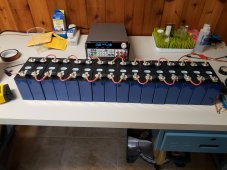rio
New Member
Hi everyone,
I am building a 16s system with CALB 100Ah cells and an Overkill 16s BMS.
The new cells arrived at about 40% SoC (according to the seller). Before top-balancing, I decided to first slowly charge them up in series (at 3A) until one cell reaches 3.55V, and then I will put them in parallel (also at 3A) to top-balance. (I'm limited to 3A because that's the limit in my benchtop CV/CC power supply - slow, I know, but that is what I have available at the moment).
Right now I'm in the series-charge process. My power supply is set to 56.8V, and it has been going steady for about 20 hours (not continuous, but maybe over 4-5 sessions). The voltage per cell started at about 3.23V and now it's just about hitting 3.38V. The Ah estimate of the Overkill app thinks I've already reached past 100Ah (which makes sense based on the time*current, though I'm sure there is no way for it to accurately have known the initial SoC).
Should I be concerned that my cell voltages are still so low? The pack is still accepting the full 3A, so charge must be building up still. Based on the charge voltage curve of LiFePO4, I am expecting a sharp rise after 99% SoC or so; I just thought I would have seen a faster rise by now. In fact, over the past 30 min or so it seems that some cell voltages have actually gone slightly down, not up.
Thanks!
I am building a 16s system with CALB 100Ah cells and an Overkill 16s BMS.
The new cells arrived at about 40% SoC (according to the seller). Before top-balancing, I decided to first slowly charge them up in series (at 3A) until one cell reaches 3.55V, and then I will put them in parallel (also at 3A) to top-balance. (I'm limited to 3A because that's the limit in my benchtop CV/CC power supply - slow, I know, but that is what I have available at the moment).
Right now I'm in the series-charge process. My power supply is set to 56.8V, and it has been going steady for about 20 hours (not continuous, but maybe over 4-5 sessions). The voltage per cell started at about 3.23V and now it's just about hitting 3.38V. The Ah estimate of the Overkill app thinks I've already reached past 100Ah (which makes sense based on the time*current, though I'm sure there is no way for it to accurately have known the initial SoC).
Should I be concerned that my cell voltages are still so low? The pack is still accepting the full 3A, so charge must be building up still. Based on the charge voltage curve of LiFePO4, I am expecting a sharp rise after 99% SoC or so; I just thought I would have seen a faster rise by now. In fact, over the past 30 min or so it seems that some cell voltages have actually gone slightly down, not up.
Thanks!




